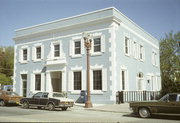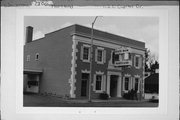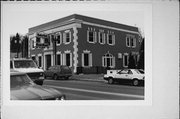Property Record
112 E CAPITOL DRIVE
Architecture and History Inventory
| Historic Name: | Bank of Hartland |
|---|---|
| Other Name: | State Bank of Hartland; Suburban State Bank |
| Contributing: | Yes |
| Reference Number: | 7906 |
| Location (Address): | 112 E CAPITOL DRIVE |
|---|---|
| County: | Waukesha |
| City: | Hartland |
| Township/Village: | |
| Unincorporated Community: | |
| Town: | |
| Range: | |
| Direction: | |
| Section: | |
| Quarter Section: | |
| Quarter/Quarter Section: |
| Year Built: | 1906 |
|---|---|
| Additions: | 1930 1916 |
| Survey Date: | 1979 |
| Historic Use: | bank/financial institution |
| Architectural Style: | Colonial Revival/Georgian Revival |
| Structural System: | |
| Wall Material: | Brick |
| Architect: | P. M. Christian; Geo. Kemnitz; Eschweiler & Eschweiler (blueprints) |
| Other Buildings On Site: | |
| Demolished?: | No |
| Demolished Date: |
| National/State Register Listing Name: | Bank of Hartland |
|---|---|
| National Register Listing Date: | 4/21/1988 |
| State Register Listing Date: | 1/1/1989 |
| National Register Multiple Property Name: | Multiple Resources of Hartland |
| Additional Information: | Another map code for this building is WK 46/33, found on the DOT Hartland map. Historical Background: Hartland's first bank was opened by George Frisbie in 1894. It was purchased by H. W. Goodwin in 1895. Previously a private bank, it was incorporated and chartered as a state bank in 1903, the "first institution in the state to take such action under the law requiring all banks to become incorporated." The bank capitalized with $10,000 and Goodwin was elected president, W. G. Smith became vice president and C. N. Nourse the secretary. (See Bib. Ref. A, B, C). The bank prospered and expanded. A savings department paying 3% on deposits of $1 or more was opened in 1912. (See Bib. Ref. D). Remodeled and expanded in 1930, the bank boasted four teller windows and an eight ton, fourteen inch thick vault door. 1930 was the bank's most successful year. (See Bib. Ref. E, F). Goodwin died in 1924 and was succeeded in the presidency by Dr. Nixon, the bank's vice president. The bank was closed by the State Banking Commissioner in 1939 for reasons that were not ascertainable. Deposits were paid off up to $5,000. (See Bib. Ref. G). Harry Goodwin, the bank's first president was a native of Hartland. He was the son of Ira Goodwin, one of the area's early settlers. Educated locally, he pursued collegiate studies in the Wisconsin State University system. He graduated from law school in 1889 and returned to Hartland where he "...makes loans, deals in real estate and does a general insurance business." In addition to his interest in the bank, he was the first editor of the Hartland News and Dairyman, as well as a partner in many local business endeavors. (See Bib. Ref. H, I). Historical Significance: The Bank of Hartland is historically significant under criterion A because of the role it played in the village's commercial and agricultural growth. From 1895 to 1920, it was the only financial institution merchants and farmers could turn to when capitol was needed for expansion. Additionally, it is significant for its association with Harry Goodwin, its first president, original editor of the local paper, and prominent local businessman. Description: The Bank of Hartland is architecturally significant as a good representation of Georgian Revival commercial architecture, and is the sole example of that mode in Hartland. Its monumental scale makes it a visual landmark in the village. The two story structure features a concrete foundation, a brick exterior, and a flat roof. Cut stone quoins and lintels are decorative elements. The Tessman Filling Station (252-256 West Capitol Drive, 1922), the Sign of the Willows (122 East Capitol Drive, 1923), and the White Elm Nursery (621 West Capitol Drive, 1928), all of which are examples of commercial residences designed in the Tudor Revival style. The 1930 redesign of the bank is a product of the firm of Eschweiler and Eschweiler, prominent Milwaukee architects of the early twentieth century. Alexander Chadbourne Eschweiler Sr. and his three sons were also responsible for the design of the White Elm Nursery and the Community Hall (built in 1922, now demolished). Some twenty of A. C. Eschweiler's buildings are listed on the National Register, including Merrill, Holton, and Johnston Halls at the University of Wisconsin-Milwaukee (1897), the Charles Allis Art Library (1909), and Saint Thomas Aquainas Catholic Church (1914), all located in Milwaukee. Architectural/Engineering Singificance: The Bank of Hartland is significant as the only Georgian Revival commercial structure in the Village of Hartland, and its monumental scale makes it a visual landmark in the village. The 1930 redesign of the bank is a product of the firm of Eschweiler and Eschweiler, prominent Milwaukee architects of the early twentieth century. Alexander Chadbourne Eschweiler, Sr. and his three sons were also responsible for the design of the White Elm Nursery (1928), and the Community Hall (1922, since demolished), and several of their buildings are listed on the National Register. |
|---|---|
| Bibliographic References: | A. Hartland News, 09/25/1897. B. Hartland News, 10/31/1914. C. Hartland News, 06/13/1903. D. Hartland News, 05/25/1912. E. Hartland News, 06/07/1930. F. Hartland News, 01/24/1930. G. Hartland News, 06/02/1939. H. Hartland News, 10/18/1924. I. Hartland News, 08/25/1906; Hartland News, 09/09/1916; Hartland News, 06/06/1930. J. Date of construction source: Blueprints, 10/17/1929. K. Historic name source: Cornerstone. |
| Wisconsin Architecture and History Inventory, State Historic Preservation Office, Wisconsin Historical Society, Madison, Wisconsin |




